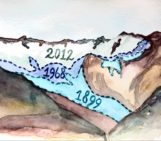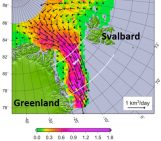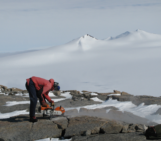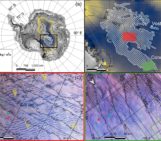
Between March and May 2007, a total of ~2,445 km2 (equivalent to over 17 football pitches) of ice mélange (a mixture of sea-ice types, icebergs and snow) and part of Voyeykov Ice Shelf in East Antarctica rapidly broke up. Observations of the timing and triggers of such events are relatively rare in East Antarctica, compared to ice shelves on the Antarctic Peninsula. Recent work highlights the important connection between this mélange and sea ice and the disaggregation of the Voyeykov Ice Shelf. Read on to find out more…
Voyeykov Ice Shelf: a hot (cold?) mess
Voyeykov Ice Shelf is a little-known, relatively small (~1650 km2) ice shelf in Wilkes Land in East Antarctica (Fig. 2). The ice shelf itself is heavily fractured and crevassed, and its lower portion ends in a complex ice mélange, which you can think of as a ‘mixing pot’ of sea ice, glacial ice and densely packed, calved icebergs (Fig. 1). This ‘mess’ acts like a glue that binds the ice shelf together. An important component of this ‘glue’ is a type of sea ice called landfast sea ice, or simply fast ice. This is sea ice that has fastened to the ice shelf, coastline, islands, or icebergs that have become stuck to the seafloor. Here, the landfast sea ice is present year-round, unlike pack ice in deep water, which forms and breaks up seasonally. Landfast sea ice can form decades-old slabs tens of metres thick!
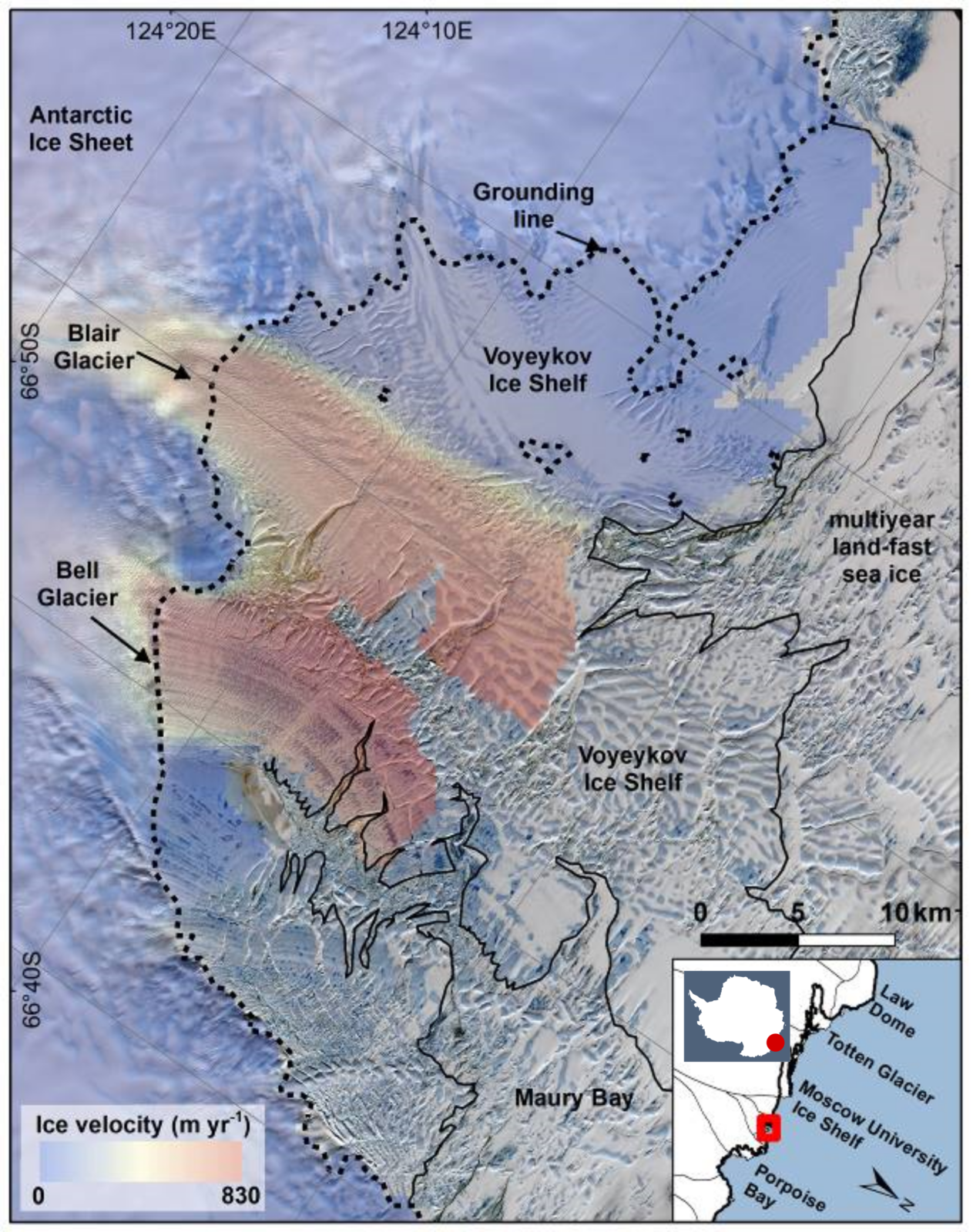
Fig. 2. Location map of Voyeykov Ice Shelf in East Antarctica. Background image is a Sentinel 2 satellite image. The colours show ice flow velocity, where pink is faster-flowing ice and blue is slower-flowing. The ice-shelf edge is shown as a black outline. The grounding line (boundary between grounded and floating ice) is shown as a dashed line. [Credit: Jenny Arthur].
So… what happened in 2007?
We know from optical satellite and radar imagery that a large-scale break-up event occurred between March and May 2007. It started when ice blocks that were mostly already detached from the ice shelf (but only bound together by mélange and sea ice) separated rapidly and were removed from the Voyeykov Ice Shelf front. This then triggered the loss of part of the intact ice shelf (Fig. 3). In total, ~2,445 km2 of ice was lost: 220 km2 was ice that broke off the ice shelf as icebergs, and the rest was already-detached ice blocks and mélange evacuated into the ocean –. This event was unusual because the ice shelf had been stable for years up until this point. –Although it has been heavily fractured for decades, the ice shelf was being ‘glued’ together by the mélange and landfast sea ice, which prevented it disaggregating.

Fig. 3. Satellite images of Voyeykov Ice Shelf before (left), and during the disaggregation event, which began with the rapid separation and removal of ice blocks that were held together by mélange and sea ice (middle) and triggered the partial loss of the ice shelf (right). [credit: Jenny Arthur]
What triggered the break-up?
The ice shelf was already fragmented and weakened by large rifts, which preconditioned the ice blocks to detach from the ice shelf – think of cracks in a windscreen that make it more likely to break up.
The timing of the break-up event also coincided with a major ‘breakout’ of landfast sea ice (Fig. 4). Arthur et al. (2021) think this could be related to unusually warm sea surface temperatures and late sea-ice advance linked to strong easterly winds which delivered warmer air to the region. Strong katabatic winds (typical cold winds that in Antarctica blow from the inner continent toward the coasts) may have also helped to weaken the landfast sea ice and blow it offshore. In fact, the ice shelf is located close to one of the windiest regions on the planet! Once the protective barrier of landfast sea ice was removed, this probably enabled warmer surface waters to weaken the mélange and ice shelf front, making it more susceptible to break-up.
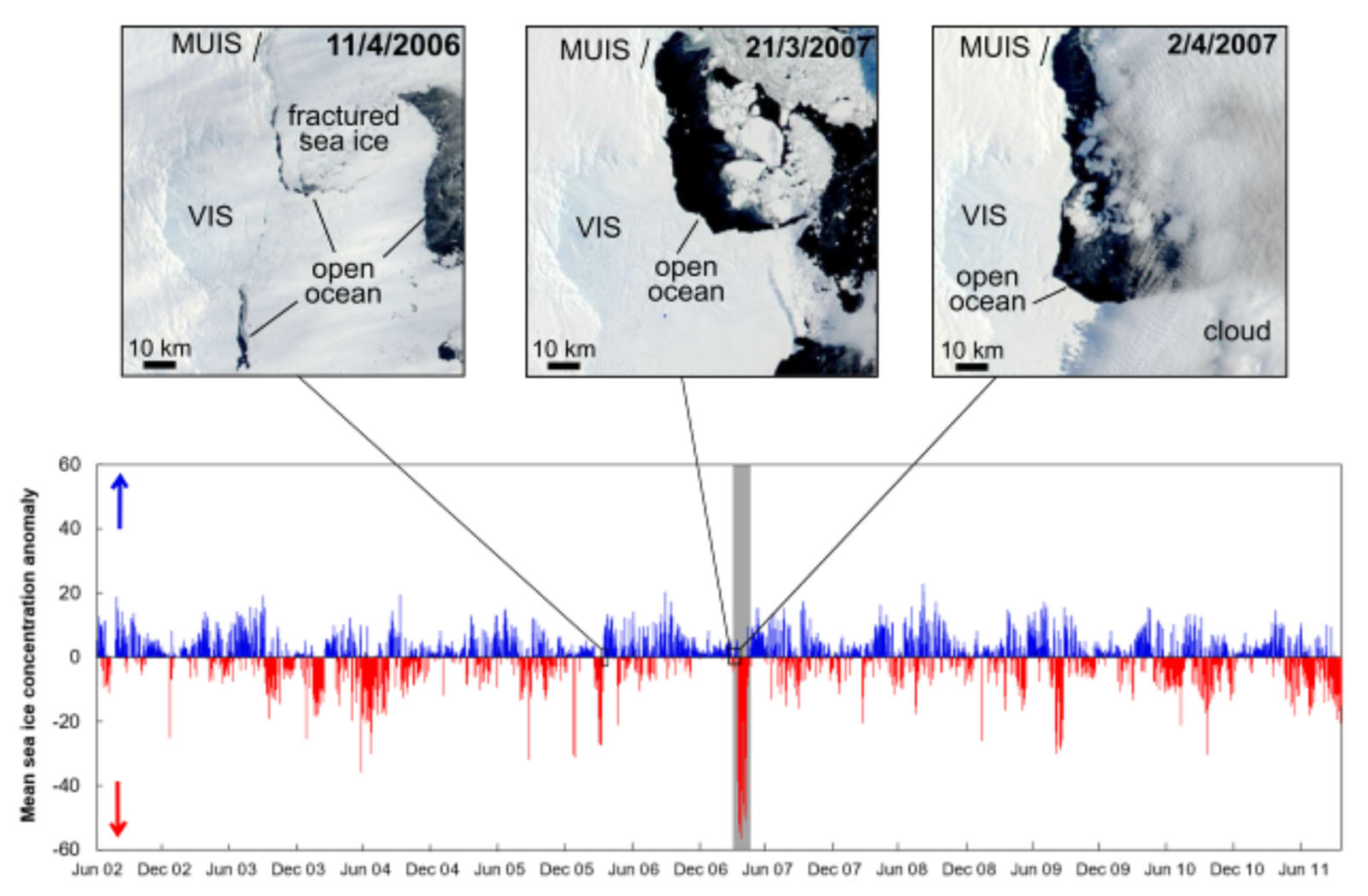
Fig. 4. Changes in daily sea-ice concentration offshore of the ice shelf from 2002 to 2011. Sea-ice concentration greater than the long-term mean is shown in blue, and sea-ice concentration less than the long-term mean is shown in red. The 2007 break-up event (shown by the grey bar) coincides with a major sea-ice breakout event. Three example satellite images show the sea ice in front of Voyeykov Ice Shelf was already weakened in 2006 (left) and the breakup of sea ice in March 2007 (middle) which led to the ice shelf disaggregating in April 2007 (right). [Credit: Jenny Arthur]
Why does it matter?
Large-scale ice-shelf retreat is important because it can reduce the back-stress exerted on ice further inland. This acts like the removal of a door stop; the glaciers feeding the ice shelf are no longer held back (the so-called “buttressing effect”, you can find some information here) and flow faster into the ocean, contributing to sea-level rise.
So far, Voyeykov Ice Shelf has advanced again since 2007 and we don’t see signs of it disaggregating imminently. Having said this, the ice shelf is still being largely held together by mélange and landfast sea ice, so any future weakening or removal of them could trigger a similar event.
Past ice shelf break-ups have been linked to surface melt ponds, as in the case of the Larsen-B ice shelf on the Antarctic Pensinsula, which collapsed in 2002. However, our work shows that the weakening and removal of mélange and landfast sea ice is another trigger mechanism of ice shelf break-up. This process could become more important in future, especially as other major ice shelves around Antarctica are, like Voyeykov, structurally-weak and are stabilised by mélange. Only the future will tell!
Further reading
If you would like to know more about the break-up event, please read our paper:
Arthur, J.F., Stokes, C.R., Jamieson, S.S.R., Miles, B.W.J., Carr, R., Leeson, A.A (2021) The triggers of the disaggregation of Voyeykov Ice Shelf (2007), Wilkes Land, East Antarctica, and its subsequent evolution. Journal of Glaciology. DOI: 10.1017/jog.2021.4
Or check out our StoryMap here.
Edited by Clara Burgard and Giovanni Baccolo
 Jenny Arthur is a PhD Student at Durham University, UK, specialising in Antarctic surface hydrology and ice shelf dynamics. She is interested in the distribution and seasonal evolution of supraglacial lakes and the potential influence of surface meltwater on outlet glacier and ice shelf stability. Her PhD research uses satellite remote sensing to investigate this on the East Antarctic Ice Sheet. She tweets as @AntarcticJenny and is part of the @EGU_CR blog team and @UKPolarNetwork. Contact Email: jennifer.arthur@durham.ac.uk
Jenny Arthur is a PhD Student at Durham University, UK, specialising in Antarctic surface hydrology and ice shelf dynamics. She is interested in the distribution and seasonal evolution of supraglacial lakes and the potential influence of surface meltwater on outlet glacier and ice shelf stability. Her PhD research uses satellite remote sensing to investigate this on the East Antarctic Ice Sheet. She tweets as @AntarcticJenny and is part of the @EGU_CR blog team and @UKPolarNetwork. Contact Email: jennifer.arthur@durham.ac.uk

